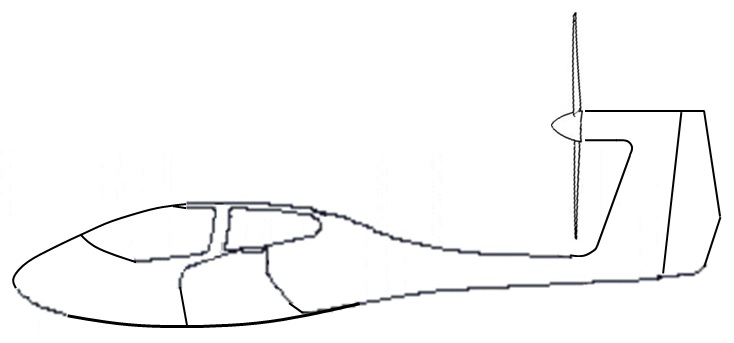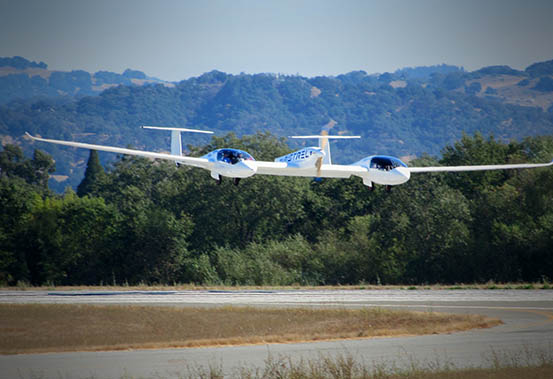A Big Win for Stuttgart Team Dipl-Ing Ingmar Geiß, Deputy Project Leader for e-Genius at the Institute of Aircraft Design at the University of Stuttgart, shared this pleasant news: “I am happy to tell you that our hybrid-electric “ECO4” has won the Berblinger Prize 2016. ECO4 combines an optimized electric airframe with a modern combustion engine generating electricity. This combination leads to an aircraft which cruises at 120 knots and consumes 40 percent less fuel than comparable state-of-the-art airplanes with conventional propulsion. As a further advantage, a small but powerful battery system enables a silent take-off without the combustion engine running, reducing significantly the noise emissions.” The Berblinger Prize Gunter Czisch, mayor of Ulm, presented the 23,000 euro ($24,035 US) prize to the team, which intends to invest the amount “directly into the further development of the airplane.” The prize was founded in recognition of Albrecht Ludwig Berblinger, “the little tailor of Ulm, who tried to cross the river …
Pipistrel, Sino GA Sign Memorandum of Agreement
China has over one billion, four hundred million people. Slovenia has a little over two million. This population disparity has not kept Pipistrel d.o.o. Ajdovscina and Chinese company Sino GA Group Co. from signing a Memorandum of Understanding for a long-term joint-venture in the field of light and general aviation in the regions of China, East Asian countries and the Asian Pacific region. Pipistrel, led by General Manager Ivo Boscarol, has built many airplanes in its 27-year history (including over 800 of its Sinus/Virus series), and earned plaudits for its clean manufacturing and ethical management. It has led in development of electric motorgliders, an electric training aircraft, and a high-performance hybrid cruiser. It won the Green Flight Challenge in 2011 with a battery powered aircraft that managed to cruise at over 100 mph for 200 miles and returned 403.5 passenger miles per gallon. That airframe has been converted to hydrogen power and was flown in September in a 10-minute demonstration …
Dr. Joseph Kallo, DLR See a Hydrogen Future
Speaking at the first annual Sustainable Aviation Symposium at the Sofitel San Francisco Bay on May 6, 2016. Dr. Joseph Kallo focused on hydrogen as a more than potential fuel for future flight. He stressed that H2 fuel development was further along than one would think, and shared several examples to promote that thought. A Busy Man, a Storied Airframe Dr. Kallo is DLR (Deutsches Zentrum für Luft-und Raumfahrt – German Center for Air and SpaceTravel) Coordinator of Electrical Aviation for Germany’s equivalent of NASA, oversees work at the DLR Institute of Engineering Thermodynamics, which has worked with Pipistrel in Slovenia to convert the Green Flight Prize winning Pipistrel G4 to the hydrogen-powered HY4. He’s also Institute Director at the Institute of Energy Conversion and Storage, Ulm University. That group provides expertise on hybridization for the HY4 project. Ulm partners with aircraft designer Pipistrel, fuel cell provider Hydrogenics, and DLR to make the aircraft a reality. H2Fly will operate the …
NASA Tests Pipistrel Systems To Aid Electric X-plane Program
Taja Boscarol of Pipistrel in Slovenia relays the information that NASA has tested Pipistrel’s electric propulsion system as part of its electric flight research for the X-57 program. It would seem reasonable to start by checking out Pipistrel’s well-tested motor package, one of the few that comes with fully-matched controller, batteries, and ancillary gear. NASA performed its tests on its 13.5-foot Airvolt stand at the Armstrong Flight Research Center at Edwards Air Force Base, California. Heavily instrumented, the Airvolt stand collects data through “high-fidelity sensors,” and transmits the collected information to a data acquisition unit that processes, records, and filters the measurements. NASA and Pipistrel should be able to make good use of this data. Normally installed on the Taurus Electro G2 motorglider, the Roman Susnik designed motor produces 40 kilowatts (53.6 hp.) at low rpm while producing high torque, an ideal combination for rapid climbs to soaring altitude. NASA will collect “torque and thrust measurements, high-fidelity voltage analysis, power …
Solar Impulse Inspires in Brussels, Heads to Paris
On June 14, 2011, Andre’ Borschberg guided the giant Solar Impulse from Brussels, Belgium, where the craft had spent the last week as the centerpiece of discussions on green energy and the future of transportation in the European Community, to Le Bourget Field just outside Paris. Nearing its destination, its daylong flight sometimes resembled the mathematical problem called, “the drunkard’s walk,” as Borschberg was vectored around the aerial neighborhoods surrounding Paris to make certain the lightly loaded craft did not run afoul of jetliners’ wakes and could find a slot where the runway did not present residual turbulence. During the preceding week, VIPs from the European Community gathered aound the airplane in Brussels to discuss the importance of this airplane and these flights. Their “Green Week” discussions evinced talk of necessity and sprouted bits of inspiration. Viviane Reding, a Vice- President of the European Union and Commissioner on Climate Change, among other responsibilities, said the “event is emblematic” of what European research, humans, …



